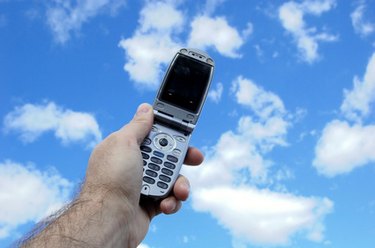
Mobile phones have been around since the 1980s; cellular technology has grown from a tool only available to the super-rich to a communications lifeline most of us can't live without. J&R Electronics says, "Among adults under age 35, cell phones have completely replaced traditional phones." The battle for this lucrative market left four major carriers in a dominant role, with AT&T and T-Mobile on the GSM (Global System for Mobile communication) standard and Sprint and Verizon using CDMA (Code Division Multiple Access) technology. The two networks of these primary carriers are designed for four types of cell phone signals.
Digital Cellular (2G)
Video of the Day
With the arrival of 2G (2nd Generation) wireless connectivity, cellular signals moved from the analog to the digital world. 2G signals are clearer and quieter than the analog ones they replaced but they can only handle data transmissions at speeds below 20Kbps. If you have an old 2G phone, you're better off sticking with regular calls or simple text messages.
Video of the Day
Packet Based Cellular (2.5G)
2.5G network enhancements bridged the gap between 2G and the massive improvement that came with 3G wireless. With dial-up data transmission speeds of 30Kbps to 90Kbps it's possible to send and receive multimedia and even to surf the Web slowly. This upgrade from 2G to 2.5G signals also improves security but it doesn't make up for the time and money you waste loading sites at dial-up speeds.
Wideband Cellular (3G)
Most phones today transmit and receive 3G signals at DSL speeds of 144Kbps to Cable speeds of 3Mbps. This dramatic improvement in bandwidth has changed mobile phones from basic communication devices to complete information portals. Now you can stream audio and video files and broadcasts to your phone and load Web sites in seconds. You can also capture and transmit audio and video recordings from your phone to the World Wide Web. AT&T even took this a step further by launching an HSDPA (High-Speed Downlink Packet Access) 3.5G network in 2006 with data transmission speeds up to 14.4Mbps.
Ultrawideband Cellular (4G)
As good as 3G is, it's performance can vary widely depending on the signal strength in your area. 4G intends to change this with an even wider bandwidth and speeds up to an unheard of 1 Gbps. It might sound like overkill but this signal's excess capacity makes it possible to get broadband speeds wherever you are. It also makes real time multimedia a reality. Imagine placing video conference and VOIP (Voice Over IP) calls from your smart phone with the same quality as your desktop computer. That's the promise of 4G and even though its current speed in early 2011 is limited to about 100 Mbps, 1 Gbps is coming.